
The Disgusting, The Formless and The Abject in Art
Estere Kajema
15/01/2016
“If the world were clear, art would not exist” – famously wrote the French author Albert Camus in his essay, The Myth of Sisyphus (1942). And he was correct, indeed – even though Marina Abramović, 33 years later, in some way disagrees with Camus by way of remarkably preaching: “Art must be beautiful, the artist must be beautiful”. In this essay, I would like to comment upon a few artworks by two French philosophers – Georges Bataille and Julia Kristeva – through a transgressive prism of thoughts, in order to prove that art does not necessarily have to be beautiful.
First of all, I would like to define the notion of Transgressive. Transgressive art is always shocking, even repulsive. It includes graphic images, often connected with anatomy – for instance, sexual acts and bodily fluids. These images may contain blood, open wounds, raw animal meat or images of various awkward body parts. Transgressive art does not have a necessity to be visual – take, for example, Vito Acconci’s work Seedbed (1972), during which an artist, for a period of three weeks, masturbated inside a gallery underneath a floor for eight hours per day while whispering such words as “you’re pushing your cunt down on my mouth… you’re pressing your tits down on my cock… you’re ramming your cock down into my ass…”[1].
George Bataille introduced the notion of “l’informe” – Formlessness. In the 1930’s, Bataille edited the Surrealist journal Documents, at which time he compiled a so-called Critical Dictionary of different ideas, theories, notions and phrases. He also came up with a definition for “l’informe”:
“A dictionary begins when it no longer gives the meaning of words, but their tasks. Thus, Formless is not only an adjective having a given meaning, but a term that serves to bring things down into the world, generally requiring that each thing have its form. What it designates has no rights in any sense and gets itself squashed everywhere, like a spider or an earthworm. In fact, for academic men to be happy, the universe would have to take shape. All of philosophy has no other goal: it is a matter of giving a frock coat to what is a mathematical frock coat. On the other hand, affirming that the universe resembles nothing and is only formless, amounts to saying that the universe is something like a spider or spit.” [2]
What Bataille means by Formlessness is that art should be brought down to earth, off of its pedestal where it has been standing since antiquity. For Bataille, creativity is in the process; it is supposed to be dirty, mixed up with ashes, mud and disgrace. The Formless, in a way, is abstract and indefinable – Bataille himself claims that a word has no definition. It is performative, rather than explanatory.
Julia Kristeva, whose ideas are often based on Bataille’s writings, introduced the notion of the Abject as “a thin line to the body and society”. The theory is partially built on semiotics and symbolism. Kristeva argues that, for instance, a corpse must be considered to be Abject, because it makes us think about our own mortality, or the mortality of other people. It is similar with blood, vomit, menstruation, feces and urine. However, the Abject might also be sensed whilst watching a film or reading a book on the Holocaust. “In the dark halls of the museum that is now what remains of Auschwitz, I see a heap of children's shoes, or something like that, something I have already seen elsewhere, under a Christmas tree, for instance – dolls, I believe. The Abjection of Nazi crime reaches its apex when death, which, in any case, kills me, interferes with what, in my living universe, is supposed to save me from death: childhood and science, among other things”.[3]
Bataille’s notion of “l’informe” and Kristeva’s Abject both represent something very simple – the indescribable. These words stand for the shivers you get when you see an open wound; the vomit reflex that takes over when you witness another person's bodily fluids. Disgust, fear, anxiety, stress, panic. Using a few works from postmodern and contemporary art history, I shall present the most Abject and Formless examples of Transgressive art.
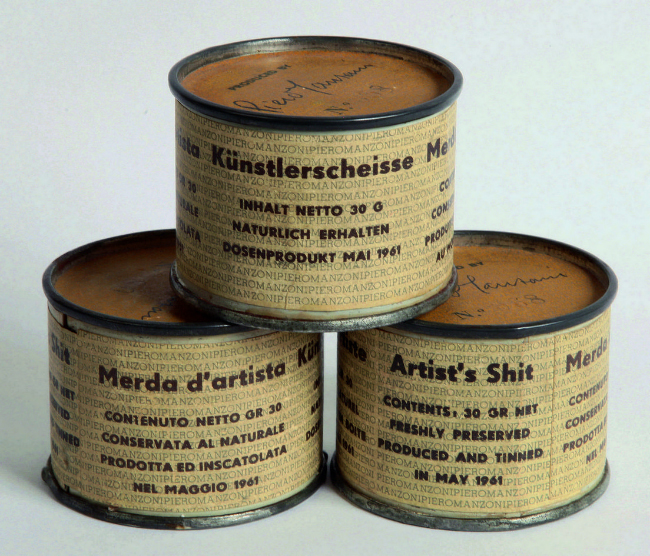
Piero Manzoni, Artist’s Shit (Merda d’artista), 1961
Pietro Manzoni, Artist’s Shit (Merda d’artista), 1961
In 1961, Piero Manzoni produced an artwork called Artist’s Shit (Merda d’artista). This work, at first sight, appears to be a regular tin can. However, if a spectator looks closer, they can read a label which says in four different languages – English, Italian, French and German - “Artist’s Shit”. Inside ninety sealed cans produced by Piero Manzoni, the artist preserved 30 grams of his own excrement. In 1961, the value of each 30g tin was only about $37, which used to be the price for 30g of gold; however, in 2008 one of the tins was valued at $150,000. The feeling of disgust and Abjection is only theoretical here – since no one has ever opened a can yet. Ignorance brings us closer to George Bataille and “l’informe”, since a can could possibly contain anything inside of it, as well as nothing at all.
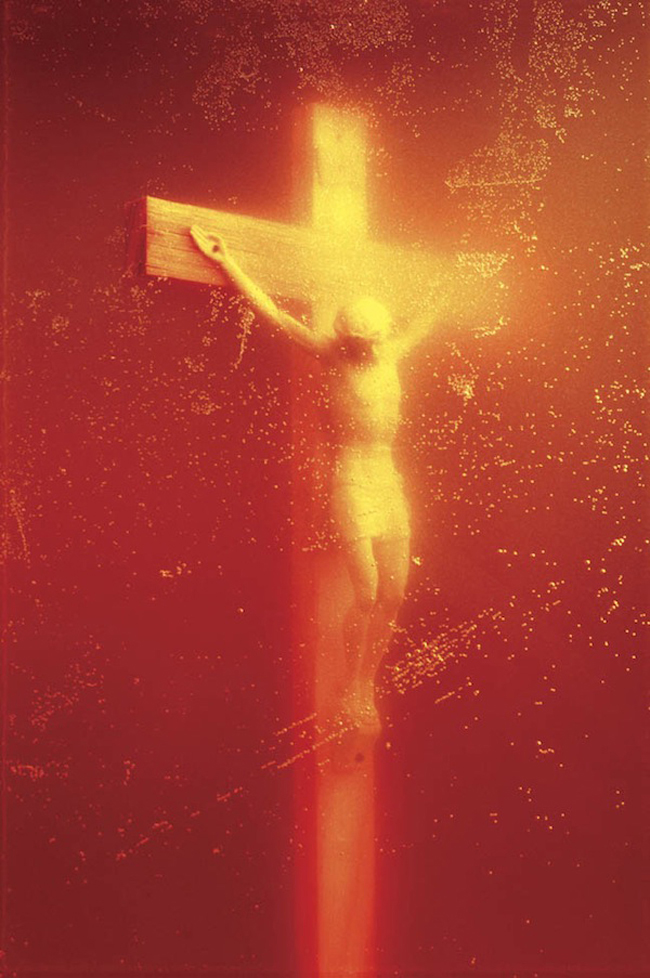
Andres Serrano. Piss Christ, 1987. Courtesy of the artist and Yvon Lambert
Andreas Serrano, Piss Christ, 1987
When Andreas Serrano created Piss Christ in 1987, his life changed very rapidly. He created a photograph depicting a very cheap, plastic crucifix standing in dirty, ill-looking urine. Serrano claimed that his aim was not to produce an object of blasphemy; through this work, he had tried to narrate a story of the commercialism and depreciation of religion in contemporary culture. Nevertheless, what one can see is a Christian symbol, a Christian relic, standing in yellow piss.
Seeing a crucifix drowning in yellow bodily fluids is incomprehensible, since the idea of besmirching something so sacred is vulgar. Yet, if Jesus Christ’s suffering was the price He needed to pay to redeem us from our sins, what is this price we literally pay to commemorate His sacrifice? People wear cheap plastic crucifixes on their chests, just like the one depicted on Piss Christ. So, could the process of dunking a crucifix into urine be an allegory for our contemporary comfort and cronyism towards religion?
Bataille himself was very interested in bodily liquids – in 1928 he published his infamous novel Story of the Eye, where through a lens of eroticism and philandering, Bataille builds up a whole package of “wet” metaphors – through milk, tears, blood, saliva, urine, semen.
Millie Brown, Nexus Vomitus, 2011. © Millie Brown, SHOWstudio
Millie Brown, Nexus Vomitus, 2011
Nexus Vomitus is a 2011 artwork by Millie Brown. To create this performance, Millie Brown sought out the help of the opera performers Patricia Hammons and Zita Syme. Whilst a spectator of the performance listens to the gracious voices of opera singers in the background, they see Millie Brown drinking colored milk and then making herself vomit straight onto a canvas, thereby creating colorful paintings. Brown says: "I drink colored milk — the process is not painful, but after several hours of vomiting it can take its toll, which is why I limit the number of colors I use. […] The use of canvas is a natural progression from my early performances. I started puking down [upon] myself in various outfits, but wanted more longevity from the end result”.[4]
Julia Kristeva would most definitely consider Nexus Vomitus to be an Abjective performance. Vomiting is an act of human nature, a rejection of a certain product, and it is hardly a process that an individual could enjoy; even more, when looking at this work, one feels immediate repugnance and a traumatic remembrance of a similar personal experience, which essentially is Abject.
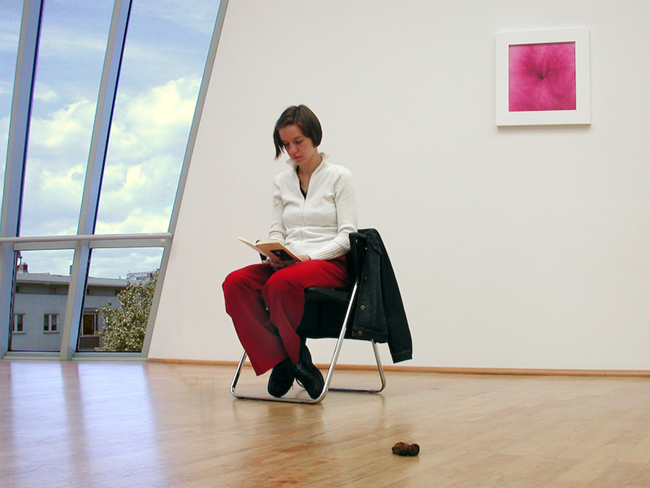
Noritoshi Hirakawa Home-Coming of Navel Strings, 2004
Noritoshi Hirakawa, Home-Coming of Navel Strings, 2004
In 2004, the contemporary Japanese artist Noritoshi Hirakawa created a performance named Home-Coming of Navel Strings, which included a young woman sitting on a chair while reading Philip Pullman’s poem. Right next to her, a spectator can see a little pile of excrement which, as soon as it dries up, is replaced by a new pile of wet and stinking feces. In the background of the performance, a viewer can see a purple painting of a sphincter, a valvular system which regulates a transition of material from one organ into another. One is likely to guess that this picture depicts an anal valve. Home-Coming of Navel Strings is a performance that demonstrates the process of reading while using the toilet – and a feeling of Abjection emerges because of shameful memories of one’s own process of defecating.
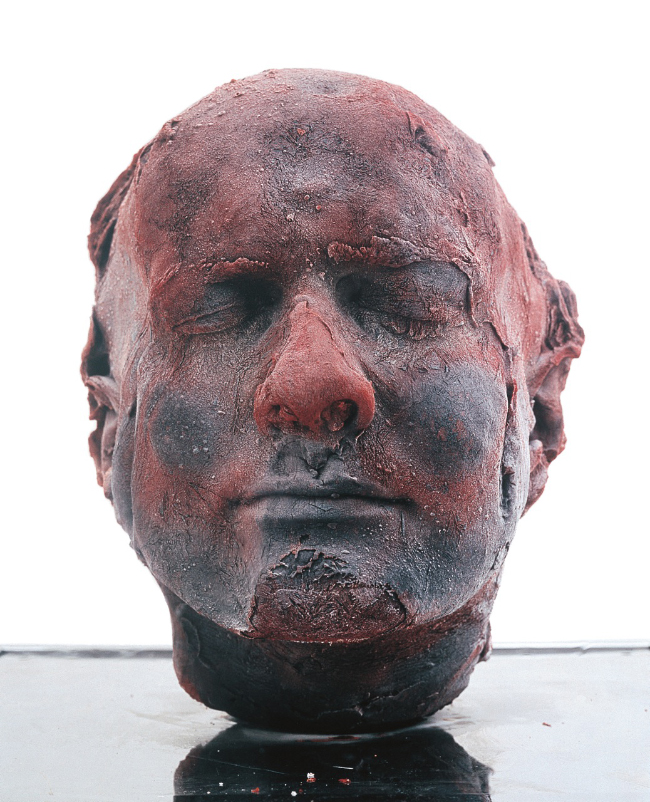
Marc Quinn. Self . Photo: marcquinn.com
Mark Quinn, Self, on-going project
Marc Quinn, one of the members of the Young British Artists, continues to work on a long, ongoing project called Self. Every five years, the artist saves up 4.5 liters of his own blood, all of which has to be collected within a period of five months. Then he freezes the blood inside a cast of his own head. The Abject usually comes from memories and personal experiences, and both Georges Bataille and Julia Kristeva find memories, experience and their influence over perception extremely crucial. The memory of having blood drawn from the body is a painful experience, or at least unpleasant. If an individual is easily shocked by blood, it might even make the spectator’s knees fold under. Even more, this artwork is supposed to remind a spectator of their own mortality – as Quinn’s face changes over time, the spectator is suddenly aware of her or his own personal processes of aging, and what is more Abject than he thought of one’s own death?
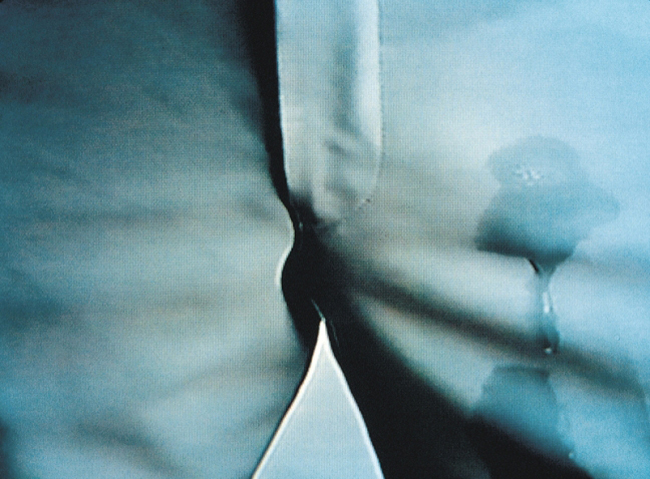
Knut Asdam. Untitled: Pissing, 1995. Video, color, no sound
Knut Asdam, Untitled: Pissing, 1995
Masculine shame is very often concerned with the humiliation of one’s male pride, one’s genitalia, and the inability to perform sexually, or, as seen in Knut Asdam’s video Untitled: Pissing (1995), the public exposure of a man pissing through his pants. For 30 minutes, in sequences of 50-70 seconds, the public watches a mute clip of a man urinating through his light-colored trousers. The work not only explores the theme of masculinity and male sexuality, but it is also looks at shame and trauma – a man who is scared of not being able to control the functions of his genitalia and urinal system; a man who finds himself being punished like a little boy who got scared and urinated in his pants. “Someone who pisses his pants is seen as someone who has lost control, who has given up and lost. In cultures with strong taboos against masturbation, wetting the bed is connected to ejaculation, but the fact that the shame associated with pissing yourself is equally enunciated in a culture where masturbation is considered a normal and integral part of sexuality, points towards more complex correlations.”[5] In this work, unlike many other art pieces showing male genitalia in full-functioning mode – for instance, Robert Morris’s work I-Box, there is no overt symbolism of male sexual power and dominance. The sex, the patriarchal strong gender, is almost absent – we can only guess at the subject's gender by way of the location of the urine stream.
To look at Untitled: Pissing from a female perspective is no less complex. For a heterosexual female, male genitalia is supposed to be a symbol of reproduction, a symbol of seduction and satisfaction. Having to stare at a crotch in such a weak and helpless state makes a woman feel uncomfortable and awkward, indeed.
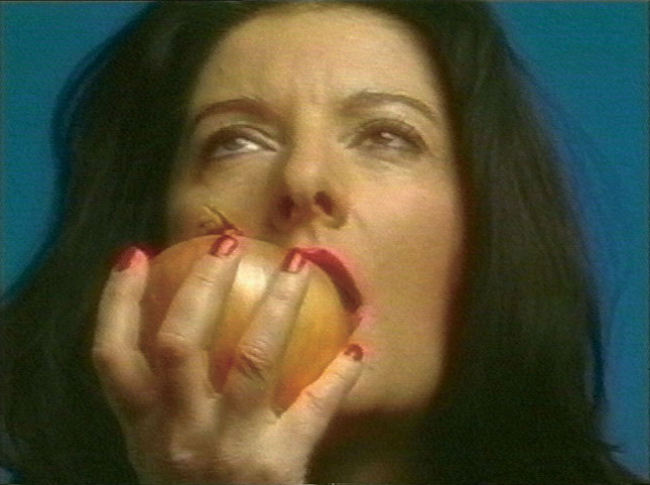
Marina Abramović , The Onion, 1996. © Marina Abramović. Courtesy of The Netherlands Media Art Institute, Montevideo/TBA
Marina Abramović, The Onion, 1996
And then, pain. Physical pain is a notion and a feeling that provokes repugnance, the desire to become as alienated as possible. Marina Abramović has created several pieces in which she experiments with her body and mind. These long-durational performances caused a lot of physical pain, and were based on patience and restraint. For instance, whilst performing The Onion (1996), Marina ate a whole large onion, with the skin on, whilst looking at the sky and meditating about her own life. She later wrote that such thoughts as: “I want to understand and see clearly what is behind all of this,”; “I am tired of migraine attacks, lonely hotel rooms, room service, long distance telephone calls, bad TV movies,”[6], were crossing her mind. While one is a spectator of this performance, one feels an awkward compassion and a clear sense of the Abject – because one remembers a time when they themselves were cutting an onion; or, on the other hand, recalling a time when they felt lonely, upset and depressed.
To talk about intimidation is not possible without thinking of Georges Bataille. For Bataille, all physical kinds of perceptions – disgust, arousal, intimidation, i.e., the uncontrollable reactions – are abstracted from vision, and because of that, they are perfect. In other words, carnal perception is compared to purification.
To conclude, The Disgusting, The Formless and The Abject are all connected between themselves. Postmodern and Contemporary Art are rapidly moving towards the unknown, the Formless – and the unknown is Abject, since it is indescribable. The Abject does not necessarily have to represent disgust. In all of the examples mentioned above, artists use their own bodies and bodily fluids to wake consciousness and its hidden nooks and crannies. They all present one universal idea – the body has limits, whereas consciousness is fully and utterly limitless.
[1] Vito Acconci, Vito Acconci: Writings, Works, Projects. US: DAP, 2001.
[2] Georges Bataille, definition of “l’informe”, “Formless” by Georges Bataille, Documents 1, Paris, 1929
[3] Julia Kristeva, Powers of Horror: An Essay on Abjection, US: Columbia University Press, 1982
[4]Huffington Post, Millie Brown Vomits To Create Art, https://www.huffingtonpost.com/2011/06/22/millie-brown-vomits-to-cr_n_881634.html#s296485
[5] Gertrud Sandqvist, “Visualizing Shame: Knut Åsdam’s Untitled: Pissing”, https://knutasdam.net/images/uploads/text/Sandquist.pdf
[6] Marina Abramović: The Artist is Present, edited by Klaus Biesenbach